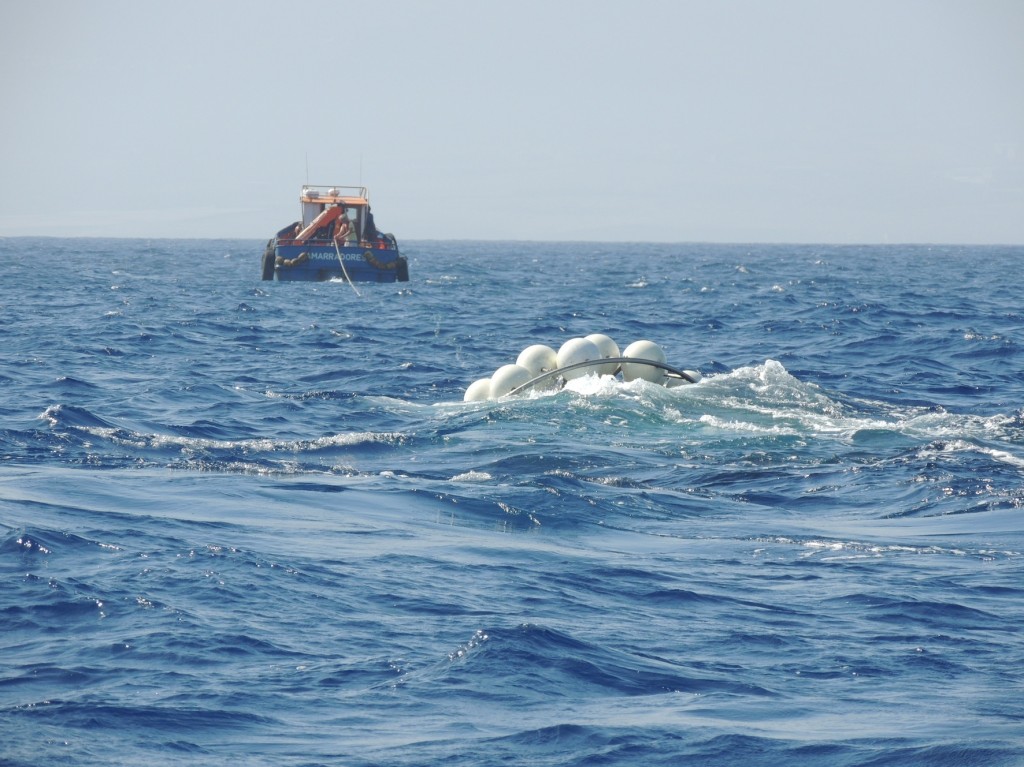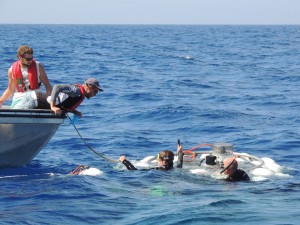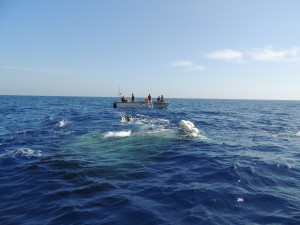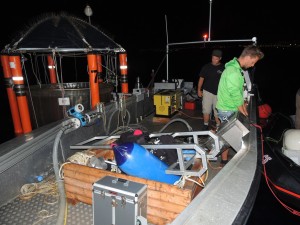It may seem like the perfect sea to swimmers, snorklers, and divers – crystal clear, turquoise water with an underwater visibility of 30 metres and more. Among marine scientists this is often referred to as an ocean desert. The concentrations of plant nutrients in these waters are so low, that it takes special instruments and a highly experienced analyst to detect them. It is the scarcity of these plant nutrients that keeps life at the edge in the waters, the number of plankton organisms low and the water crystal clear. During the first part of our experiment, these were also the conditions in our mesocosms.
But occasionally parts of these ocean deserts are turned into plankton paradise. Unlike in real deserts, it’s not the rainwater from above but the deep water from below that makes life flourish. In much of the tropical and subtropical open ocean, these events are driven by swirling currents, so-called eddies, which can push nutrient-rich deep waters into the sunlit surface layer. These eddies are also common features in the wake of islands and are a well-known phenomenon south of the Canaries.
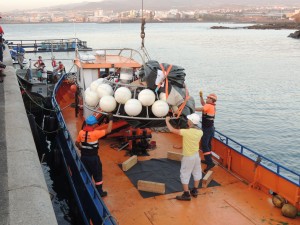
Loading of the deep-water collector on the chartered vessel SEPCAN IV
To simulate such an event in our mesocosms, we collected 80,000 litres of deep water at 650 m depth five nautical miles off-shore in a giant plastic balloon, which was then towed to our mesocosm playground. During the night from October 25 to 26, the deep water was then distributed into our nine mesocosms, making sure that all mesocosms ended up with precisely the same deep-water mixing ratio. Doing this over night avoided nutrients being consumed by the nutrient-starved phytoplankton before we could even measure their initial concentrations. It didn’t take long for the phytoplankton to respond – a couple of days after deep-water addition the plankton party is in full swing. To capture the rapid changes, we decided to further increase our sampling frequency – ignoring for the time being that our own batteries are gradually running down.
Now we are eagerly watching the party in our enclosed biospheres and hope to learn more about the rules of switching from ocean desert to plankton paradise. Who can make the best use of the nutrient boon? How efficient is the plentiful food transferred up the food web? What are the consequences for elemental and energy fluxes und air-sea exchange? And what are the impacts of ocean acidification on all these processes?
Wie ozeanische Wüsten sich in ein Planktonparadies verwandeln
Für Schwimmer, Schnorchler und Taucher mag es wie der perfekte Ozean anmuten – kristallklares, türkisblaues Wasser mit einer Unterwassersicht von 30 Metern und mehr. Unter Meereswissenschaftlern wird es oft als ozeanische Wüste bezeichnet. Die Konzentration an Pflanzennährstoffen in diesen Gewässern ist so niedrig, dass es spezieller Messinstrumente und erfahrener Analysten bedarf, um sie nachzuweisen. Dieser Mangel an Nährstoffen hält das Leben kurz , die Zahl der Planktonorganismen gering und das Wasser kristallklar. Dies waren die Bedingungen in unseren Mesokosmen während Teil 1 unserer Studie.
Hin und wieder verwandeln sich Teile dieser ozeanischen Wüsten allerdings in ein Planktonparadies. Im Gegensatz zu tatsächlichen Wüsten ist es nicht das herabregnende Wasser von oben, sondern Wasser aus der Tiefe des Ozeans, welches das Leben erblühen lässt. In großen Teilen der tropischen und subtropischen Meere werden solche Ereignisse durch ozeanische Wirbel, sogenannte Eddies, ausgelöst, die nährstoffreiches Wasser aus der Tiefe in die lichtdurchflutete Oberflächenschicht transportieren. Solche Eddies treten häufig im Strömungsschatten von Inseln auf und werden auch südlich der Kanaren permanent gebildet.
Um ein solches Ereignis auch in unseren Mesokosmen zu simulieren, haben wir fünf Meilen vor der Küste in 650 Metern Tiefe 80.000 Liter Tiefenwasser in einen riesigen Plastikballon gepumpt und diesen dann zu unserer Mesokosmen-Spielwiese gezogen. In der Nacht vom 25. auf den 26. Oktober haben wir das Tiefenwasser dann auf die neun Mesokosmen verteilt. Ganz wichtig: alle Mesoksomen mussten exakt das gleiche Mischungsverhältnis bekommen. Und alles musste in einer Nacht über die Bühne gehen, um die Ausgangskonzentrationen der Nährstoffe bestimmen zu können, bevor das lichtabhängige Phytoplankton sie aufnehmen konnte. Tatsächlich ließ die Reaktion des Phytoplanktons nicht lange auf sich warten. Jetzt ist die Planktonparty in vollem Gange. Weil bei im warmen Wasser und bei den hohen Lichtintensitäten alles sehr schnell geht, haben wir unser Mess- und Probenahmeintervall noch einmal verkürzt – auch wenn es tüchtig an den Kräften zehrt.
Gespannt schauen wir dem bunten Treiben in unseren eingeschlossenen Welten zu und hoffen, so mehr über den Wechsel von ozeanischen Wüsten zu Planktonparadiesen zu lernen. Wer kann den Nährstoffsegen am besten nutzen? Wie effizient wird das reichhaltige Futterangebot im Nahrungsnetz weitergereicht? Was bedeutet dies für die Stoff- und Energieflüsse und den Austausch zwischen Ozean und Atmosphäre? Und welchen Einfluss hat Ozeanversauerung auf all diese Prozesse?
